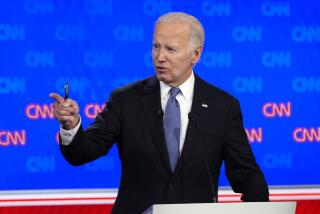Op-Ed: An Alzheimer’s epidemic is coming. Here’s how to prepare
Mention the words “women’s health,” and Alzheimer’s disease may not immediately come to mind. It should.
The greatest emerging risk to women’s health can be summed up in this stark statistic: Every 65 seconds in the United States a new brain develops Alzheimer’s. Two-thirds of them belong to women, and no one knows why that is.
For a woman over 60, the risk of developing Alzheimer’s at some point in her lifetime is twice as great as that of developing breast cancer. People of color are also at a greater risk for the disease, with African Americans twice as likely and Latinos 1.5 times as likely to develop the disease as whites.
Every 65 seconds in the United States a new brain develops Alzheimer’s. Two-thirds of them belong to women, and no one knows why that is.
In California, we have more people living with Alzheimer’s than in any other state. We also have the highest number of family caregivers. We talk a lot about preparing for the next huge earthquake, but Alzheimer’s is another “Big One” facing California, and we just aren’t sufficiently prepared.
In his 2019-2020 budget, Gov. Gavin Newsom has allocated $3 million in state funds to support research that will help us better understand the greater prevalence of Alzheimer’s among women and people of color. He is also establishing a task force on Alzheimer’s prevention and preparedness, which will report to him how California can ready itself for the increase in cases and what government can do to help families who are facing this insidious disease. These are excellent steps, but more is needed.
Projections from the Department of Finance estimate that by 2060 more than one in four Californians will be 65 or older — nearly double the percentage of residents in that age cohort today. And according to a recent poll conducted by the Women’s Alzheimer’s Movement and Genworth, the majority of Americans say they aren’t prepared financially for aging or caregiving and they want the government to step up and help.
While the challenges presented by this demographic shift are many, arguably none is more severe than the implications for a spike in the number of Californians stricken with Alzheimer’s. About one in 10 Americans over age 65 and about one in three over age 85 are living with the disease. In California, the number of people with Alzheimer’s is projected to soar by nearly a third in just the next six years.
Alzheimer’s is a nonpartisan issue, which should make it easy for the Legislature to embrace Newsom’s proposal to strengthen California’s preparation for the demographic challenges ahead. I’ve testified twice before Congress for increased national funding. Now I want to see my home state step up on this issue and lead the country forward.
Enter the Fray: First takes on the news of the minute »
California is home to 10 Alzheimer’s Disease Centers, the most in any state. It has a university system that is second to none. And now, we also have a bold new governor who watched his father grapple with dementia in his final months. During his tenure as San Francisco mayor, Gov. Newsom contributed to the “2010 Shriver Report: A Woman’s Nation Takes on Alzheimer’s,” which reported for the first time that women are at an increased risk for the disease.
I am excited for California to lead the way on this issue. I’m excited that so many people want to come together and figure out why women and people of color are at higher risk. I’m excited that smart individuals want to put their heads together and figure out how to prepare our state for this disease and how to better care for our aging population.
In doing so, California can help chart a course for the nation, as it has already done on so many other issues.
Maria Shriver is an NBC journalist and author who founded the Women’s Alzheimer’s Movement. She served as first lady of California from 2003 to 2011.
More to Read
A cure for the common opinion
Get thought-provoking perspectives with our weekly newsletter.
You may occasionally receive promotional content from the Los Angeles Times.










